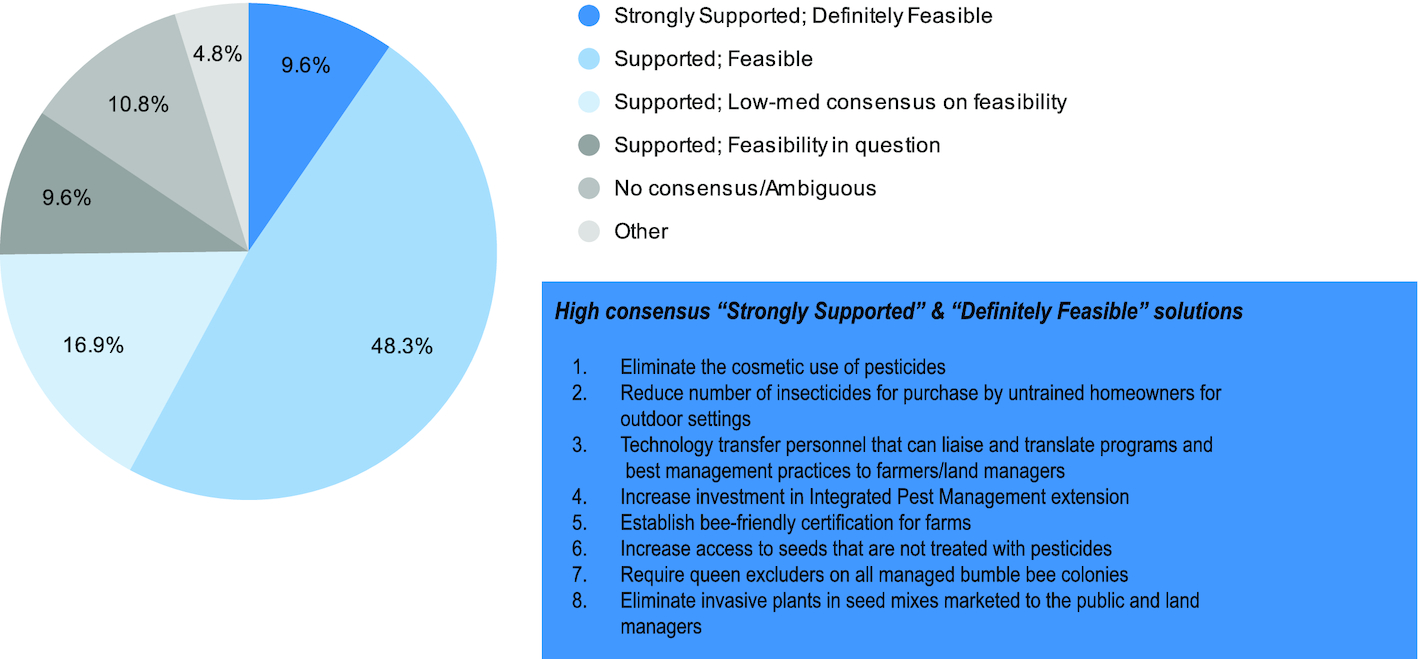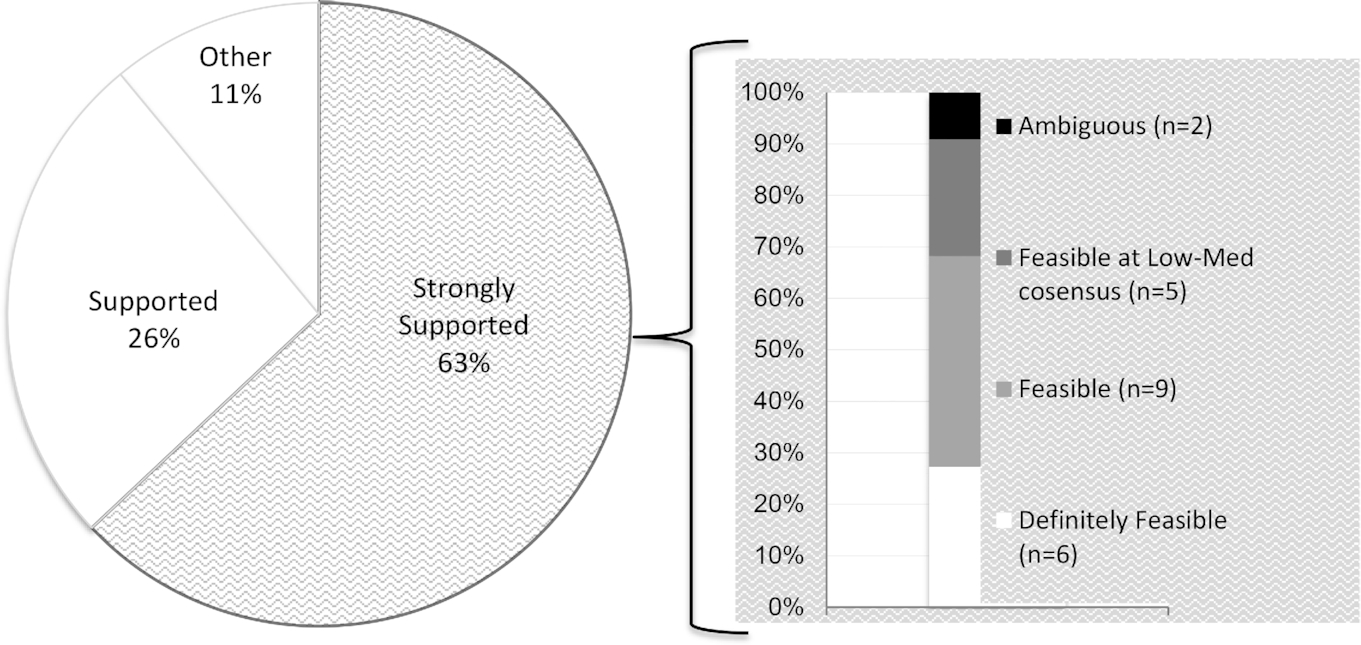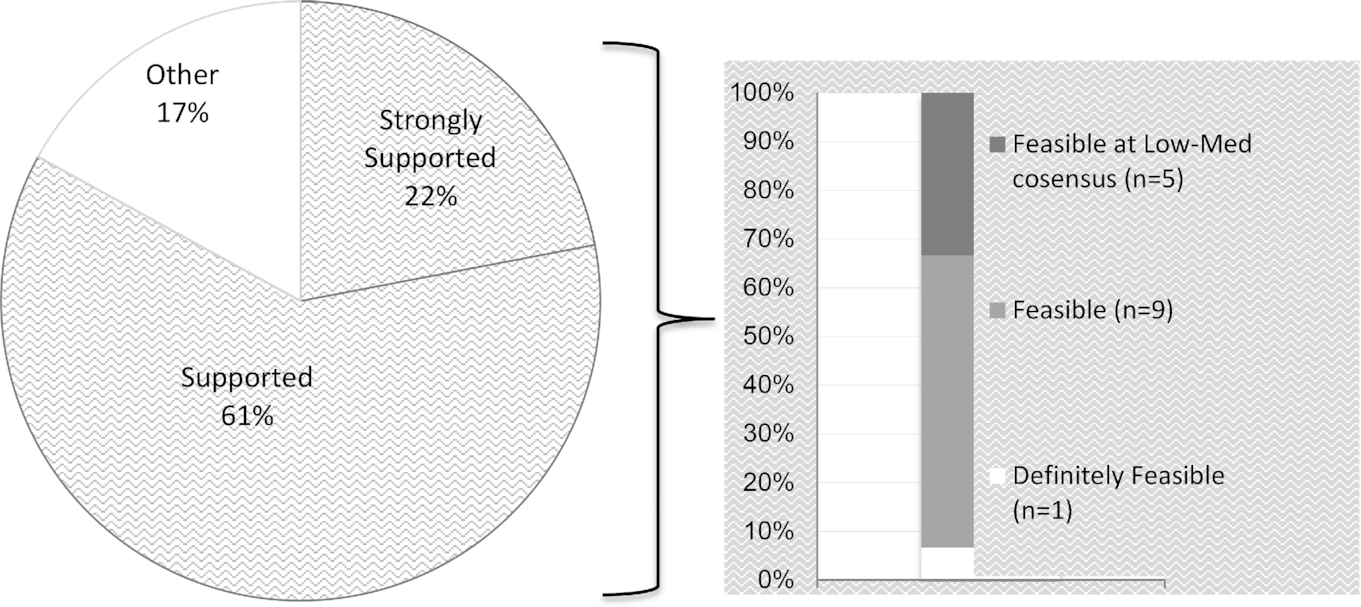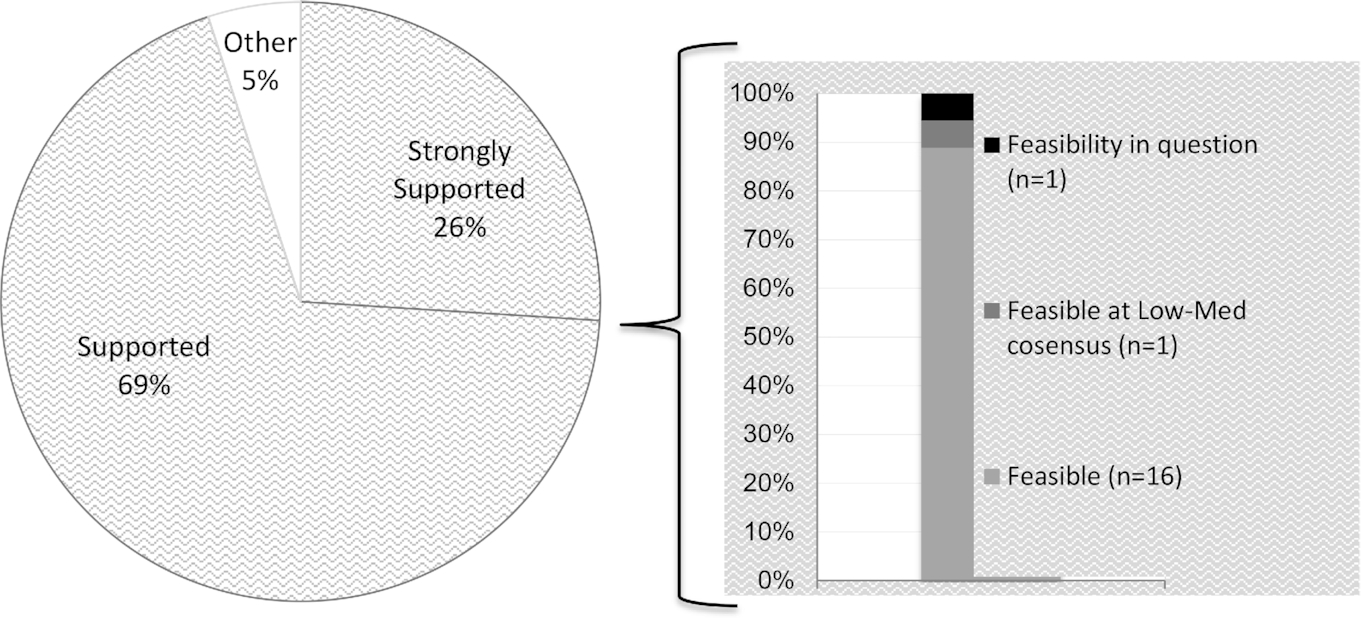Toward a wild pollinator strategy for Canada: expert-recommended solutions and policy levers
Abstract
Introduction
Methods
Delphi technique
Participants
Survey design, implementation, and data analysis
Round One
Round Two
| Unit of analysis | Definition | Categories |
|---|---|---|
| Consensus | Measure of the degree to which the panel agreed on the desirability or feasibility of a proposed solution | High: 70% of ratings in one category or 80% in two contiguous categories Medium: 60% of ratings in one category or 70% in two contiguous categories Low: 50% of ratings in one category or 60% in two contiguous categories None: <60% of ratings in two contiguous categories Ambiguous: Consensus split among categories |
| Point of consensus | Indicates where the consensus opinion fell on the support rating scale (if any consensus existed) | ● Strongly Support (SS) ● Strongly Support-Weakly Support (SS-WS) ● Weakly Support (WS) ● Weakly Support-Weakly Oppose (WS-WO) ● Weakly Oppose (WO) ● Strongly Oppose-Weakly Oppose (SO-WO) ● Strongly Oppose (SO) |
| Indicates where the consensus opinion fell on the feasibility rating scale (if any consensus existed) | ● Definitely Feasible (DF) ● Definitely Feasible-Somewhat Feasible (DF-SF) ● Somewhat Feasible (SF) ● Somewhat Feasible-Somewhat Infeasible (SF-SI) ● Somewhat Infeasible (SI) ● Definitely Infeasible-Somewhat Infeasible (DI-SI) ● Definitely Infeasible (DI) | |
| Polarity | Variance of the distribution | Strong ≥ 1.5 Weak ≥ 1.2 and < 1.5 None < 1.2 |
| Strongly Support | Weakly Support | Weakly Oppose | Strongly Oppose | Consensus level | Point of consensus | |
|---|---|---|---|---|---|---|
| Support: | ||||||
| Responses | 13 | 2 | 2 | 0 | High | Strongly Supported (SS) |
| % w/opinion | 76.4% | 11.8% | 11.8% | 0% | ||
| Definitely Feasible | Somewhat Feasible | Somewhat Infeasible | Definitely Infeasible | Consensus level | Point of consensus | |
| Feasibility: | ||||||
| Responses | 6 | 9 | 2 | 0 | High | Feasible (DF-SF) |
| % w/opinion | 35.3% | 52.9% | 11.8% | 0% | ||
Results
Overall solutions results
| Strongly Support | SS-WS | Weakly Support | WS-WO | Weakly Oppose | WO-SO | Strongly Oppose | Ambiguous | None | Total | |
|---|---|---|---|---|---|---|---|---|---|---|
| Consensus | ||||||||||
| High | 42.2% | 45.8% | 2.4% | 0.0% | 0.0% | 0.0% | 0.0% | 90.4% | ||
| Med | 0.0% | 3.6% | 0.0% | 0.0% | 0.0% | 0.0% | 0.0% | 3.6% | ||
| Low | 0.0% | 0.0% | 0.0% | 2.4% | 0.0% | 0.0% | 0.0% | 2.4% | ||
| Ambiguous | 2.4% | 2.4% | ||||||||
| None | 1.2% | 1.2% | ||||||||
| Total | 42.2% | 49.4% | 2.4% | 2.4% | 0.0% | 0.0% | 0.0% | 2.4% | 1.2% | 100.0% |
| Definitely Feasible | DF-SF | Somewhat Feasible | SF-SI | Somewhat Infeasible | SI-DI | Definitely Infeasible | Ambiguous | None | Total | |
|---|---|---|---|---|---|---|---|---|---|---|
| Consensus | ||||||||||
| High | 9.7% | 48.2% | 3.6% | 3.6% | 1.2.% | 0.0% | 0.0% | 66.3% | ||
| Med | 0.0% | 14.5% | 2.4% | 3.6% | 0.0% | 0.0% | 0.0% | 20.5% | ||
| Low | 0.0% | 1.2% | 1.2% | 2.4% | 0.0% | 0.0% | 0.0% | 4.8% | ||
| Ambiguous | 7.2% | 7.2.% | ||||||||
| None | 1.2% | 1.2% | ||||||||
| Total | 9.7% | 63.9% | 7.2% | 9.6% | 1.2% | 0.0% | 0.0% | 7.2% | 1.2% | 100.0% |

Results for individual stressors
Pesticides

| Reduce access to pesticides |
Solution (S4): Restrict the use of pesticides only to when there is an evidence of need Feasibility: Ambiguous “Economic thresholds are not always well researched, in part because of cutbacks in government ag research (companies don't necessarily have an interest in this unless they recognize that their product won't last without conjoint IPM implementation). Provincial ministries of ag have cut back on the infrastructure for advising farmers on economic thresholds (IPM staff, phone alert systems, extension bulletins and up to date web sites, etc). Farmers don't necessarily have the skill to properly scout and assess and won't necessarily pay for private scouting services. Many of these services have collapsed financially” “This is a good plan. However it requires some on the ground research and extension work for every crop to develop the necessary threshold information. If threshold information is reliable, growers will use it for sure. BUT [sic] you have to have reactive tools available” “Growers love seed applications because they are done at the point of production rather than on the farm, they tend to pose less risk to applicators, and they are super easy to use. Such applications are usually systemic. If pesticides are sprayed in reaction to a pest, there are many other problems associated with that methodology, some of which are environmental and some relate to human health” |
| Reduce reliance of agricultural systems on pesticides |
Solution (S16): Adopt targeted crop insurance programs Feasibility: DF-SF “This approach is excellent as it provides the safety net for producers that might allow them to have the confidence not to use prophylactic pesticide applications. This has been shown to work on a local scale in parts of Italy, and works well. “In an era of climate change and unpredictable markets, insurance that provides real time relief to producers is critical. Again if all the money we currently wasted on unfair subsidies to meat, dairy, egg and corn producers was diverted to a robust insurance program, this would be feasible |
| Improve the Canadian government's approach in assessing pesticide risk to pollinators |
Solution (S21): National pesticide use survey for all crops every 3 years Feasibility: Med. consensus DF-SF “I am not sure if this would be feasible in the long term. Lots of new chemicals come and go, and changing governments may not see this as a priority down the road” “Definitely implementation challenges. Pieces of this have been done in the past (through things like FEMS) but the questions weren't well designed. Nobody really wants to pay for this as part of the Census of Agriculture. Ontario has been doing it every 5 years, but the survey isn't well designed. Survey design is critical” Solution (S13): Apply the precautionary principle in the approval of new pesticides Feasibility: Med. consensus DF-SF “It is going to make registering new pesticides in Canada very cost prohibitive, putting our agricultural sector at great disadvantage if the U.S. does not follow suit (and it won't). Companies will just not bother registering their products in Canada. This is already happening in the biological control sector” “The issue is that the federal Pest Control Products Act (PCPA) does not translate the language of precaution from the preamble to the operational logistics of data collection and approval processes. So this requires a major rewrite of the bill, the regulations and the regulatory protocols” |
| Research gap themes: pesticides | Example/s |
|---|---|
| Expanding assessments to include more species (n = 16) | “Expanding species assessed in impact studies and regulatory frameworks beyond honey bees and a few eusocial species of native bees” |
| Alternatives (n = 12) | “Increased research into biological control methods, crop rotation and mechanical control methods could reduce the need for pesticides” |
| Routes/parameters of exposure (n = 8) | “What is the coefficient of transference between soil-borne pesticide residues and ground-nesting bees?” |
| “Differences between foliar vs. systemic pesticide use” |
Pathogens

| Reduce pathogens in managed pollinators |
Solution (S37): Establish clean stock program that tracks the movement and quantity of independently tested pathogen-free bumble bees Feasibility: DF-SF “This seems desirable and realistic to achieve. I am sure there would be pushback from the commercial bumblebee producers, but it would remove elements of doubt about whether or not colonies going to glasshouses or field pollination sites are “clean” when they are put in place. A key question would be which parasites and pathogens to include. Would this be limited to Nosema, Crithidia, Apicystis, Spherolaeria and mites, or would this also include viral infections?” “Traceability of the movement of any livestock (bees included) is a practice that should be in place; allowing movement of independently tested “clean” bees would be even better. Cost and enforcement will present challenges. Who pays for the independent testing and movement certificates? The supplier? The grower?” Solution (Q43): Require screening and health certificate before any movement of managed honey bees Feasibility: SF-SI “This seems realistic for inter province/territory movement, but would likely be too cumbersome to operate within a province or territory due to the numbers of operators moving honey bees. The costs in terms of time and personnel would be very high to run, regulate and enforce such a program” |
| Reduce pathogen spillover and spillback between managed and wild pollinators |
Solution (S45): Only allow the use of commercial bees (honey bees excepted) within their native range Feasibility: DF-SF “Definitely feasible as we currently do not allow import of bumblebee colonies into Newfoundland and Labrador as B. impatiens is not native here. It has presented some challenges convincing cranberry and blueberry growers that our native pollinators are doing the job. Have also encountered a few greenhouse growers seeking advice on pollination options” “This is feasible, but would require their native ranges to be defined. Would recent expansions of Bombus impatiens be considered nonnative expansions (I would suggest yes, but this might not prevent them widening their area of occupation in southern British Columbia and Alberta). This would certainly require commercial production of a western bumblebee species, and possibly other managed solitary bees to be developed” Solution (S47): Ban honey bees from public lands Feasibility: Low consensus DF-SF “You can potentially prevent the physical colonies being placed in some public lands (but e.g., Ontario Crown Lands, anyone can go in and hunt or remove materials, so why legislatively wouldn't you be allowed to put colonies there?) but if you put the physical hives within a few km of the public lands, the bees will still visit. I've heard of beekeepers putting their hives on the edge of the public area on a neighbouring property so their bees can go and forage on the public land” Solution (S42): Regulate greenhouses to make sure they are adhering to best practices and are designed to prevent pathogen spillover Feasibility: Med. consensus SF-SI “Generally they are encouraged already; who is going to enforce?” |
| Research gap themes: pathogens | Example/s |
|---|---|
| Characterizing pathogen “spillover” and “spillback” between managed and native pollinators (n = 14) | “Characterizing and understanding the complexity and extent of pathogen transmission networks in the field. Key questions are whether pathogen transfer occurs primarily from managed pollinators to wild species (spillover), vice versa (spill-back), or significantly in both directions” |
| “How can floral resources mitigate or contribute to pathogen spread?” | |
| Effects/ability of pathogens to cause disease (n = 7) | “Establishing the importance of different pathogens on a wider range of pollinator taxa. Many studies use molecular approaches to detect presence and/or prevalence of pathogens, but this is not the same as establishing infection has occurred or indeed the extent of impacts of infections” |
| Determine (background) pathogen load in native pollinators (n = 5) | “Determining the number of pathogens infecting wild pollinator species and the extent to which these overlap with pathogens already characterized as infecting managed honey bees or bumble bees” |
Habitat loss

| Expand and protect pollinator habitat |
Solution (S56): Tax break to homeowners that plant pollinator-friendly alternatives to turfgrass Feasibility: Med. consensus SF-SI “Do you mean property tax break? Hard to implement when municipalities are so strapped for cash…our options to reduce municipal property taxes are limited unless the provinces change how municipalities are funded” “This is certainly desirable, but may come with challenges from homeowners associations because of worries that things look “messy”. May also need to specify that “x% of the lawn needs to be pollinator friendly” |
| Ensure quality of expanded habitat |
Solution (S59): Support more native plant nurseries/producers Feasibility: DF-SF “…Bigger landscape contractors are used to the ease of buying from big companies for certain prices. Will take consumer demand and price comparisons to make this more feasible” |
| Research gap themes: habitat loss | Example/s |
|---|---|
| Baseline data and monitoring (n = 10) | “Native pollinator communities are not benchmarked in many landscapes. This gap makes it difficult to interpret the impact of habitat alteration/fragmentation” |
| “No comparative data for population sizes for different functional trait groups, more extensive studies are needed” | |
| Requirements (n = 8) | “An increased focus on understanding nesting requirements/preferences for native pollinators, particularly those that are common in agricultural systems. This also needs to include overwintering sites. Without appropriate places to construct nests, it doesn't matter how many flowers there are!” |
| “Need to know how much habitat pollinators actually require in a landscape” | |
| Land-use effects on pollinators (n = 6) | “The scale at which fragmentation affects bee biology” |
| “Disentangling the relative influence of habitat loss and fragmentation on bee population (declines) and pollination effectiveness” |
Nonnative species
| Generalized, high-level actions to halt the entry or spread of potentially invasive species |
Solution (S79): Increase surveillance using all available technology (Note: Example given was environmental barcoding) Feasibility: Med. consensus SF-SI “Is good in theory to do more monitoring. e.g., CFIA is doing some, and community scientists and researchers are keeping their eyes open for new or different looking things, but it's not as if we have the financial, technical, or HQP to frequently test e.g., every possible border crossing, every new shipment of materials, etc. eDNA is doing great things, but you need to have the barcodes in the database to match your unknown with…” |
| Removal and prevention of invasive plant species |
Solution (S77): Subsidize invasive plant removal and restoration Feasibility: DF-SF “Feasibility depends strongly on the type of plant and the extent to which it has become embedded in the landscape. Many very widely spread species of plant are invasives [sic] from Europe that would be uneconomical to try and eliminate as they are widely established across the whole of/or large parts of the country. More recent invasions by plants might be more realistically controlled in this way” |
| Policies that reduce potential competition of wild pollinators (specifically bees) with nonnative bees |
Solution (S81): Label or certify wild-pollinated crops Feasibility: DF-SF “Too difficult to inspect and certify, unless based strictly on distance of farm from commercial nonnative bee operations” |
| Research gap themes: nonnative species | Example/s |
|---|---|
| Effects of nonnative bees on native bees through competition and disease introduction (n = 8) | “Research on interaction (competition) between managed bees (honey bees primarily but also other managed bees such as nonnative bumbles or leafcutters) on native bees in agricultural landscape” |
| Characterizing plant–pollinator networks (n = 4) | “Research/info on benefits of native plants and reduction of nonnatives/invasives to native bee populations… And in urban environments this research can help educate on benefit of native plantings and inform municipal policy for municipal lands” |
| “Understanding the frequency and extent of impacts of nonnative plant species on plant–pollinator visitation and pollination networks. Invasive plants can restructure native networks by offering super abundant floral rewards and monopolizing attention from flower visiting species” | |
| Prevention (n = 4) | “How to keep queens and males inside the managed bumble bee colonies and not allow them to escape” |
| “Keep out the nonnative species? Some areas will have these interactions due to climate change and southernly species moving north” |
Discussion and next steps
Acknowledgements
References
Supplementary material
- Download
- 15.32 KB
- Download
- 106.33 KB
Information & Authors
Information
Published In

History
Copyright
Data Availability Statement
Key Words
Sections
Subjects
Plain Language Summary
Authors
Author Contributions
Competing Interests
Funding Information
Metrics & Citations
Metrics
Other Metrics
Citations
Cite As
Export Citations
If you have the appropriate software installed, you can download article citation data to the citation manager of your choice. Simply select your manager software from the list below and click Download.
There are no citations for this item
